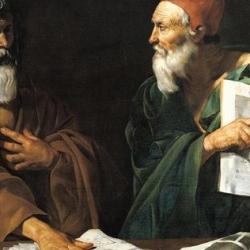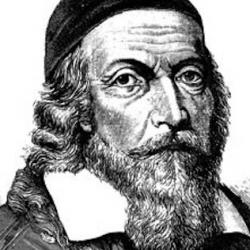I have been greatly helped here by Cynthia Nielsen’s online summaries of Marion’s book.
1) One of Marion’s main ambitions is to move beyond the Western concern with being with its concomitant focus on the “object.” In place of “objectness,” a static notion of the things of the world, Marion wants to show that the fundamental reality of things is “givenness,” a more dynamic idea: the phenomenon should be understood “no longer as object or being, but as given” (p 3). His “one and only theme” is “what shows itself first gives itself” (p 5). He wants to overcome the common reading that would hear in his title “Being Given” a metaphysical collapse of the given into being. Instead, he intends his title to mean that being “discloses it as a given, owing nothing to anybody, given inasmuch as given, organized in terms of givenness and even employing ‘being’ therein” (pp 1-2). Ultimately, this also involves a subversion of the modern conception of the subject, which Marion wants to call “the gifted,” and who is a subject by “his capacity to receive and to receive himself from what he receives” (p 4; book 5).
2) In order to achieve this, Marion embarks on a critique of Husserl and various formulations of phenomenological principles and methods. Husserl remains bound by metaphysics, partly because he limits givenness by what is available to intuition. For Marion, “the pure given giving itself depends, once reduced, only on itself. Intuition in particular, thus also the transcendence of intentionality that it fulfills, can sometimes intervene, but it does not define the given.” Intuition “suffers limits” but “givenness knows none. What gives itself, insofar as given in and through reduced givenness, by definition gives itself absolutely” (p 17). Husserl also remains bound to the metaphysical paradigm of the object, which Husserl virtually equates with being: “Immanent or absolute Being and transcendent Being are, of course, both called ‘being,’ ‘object.’” Husserl maintains the “privilege of primordial objectness” only by “the subsuming of what appears and is given in a category that is not given and does not appear” (p 31). Marion maintains, on the contrary that objectness is simply one mode of givenness: “objectness is reduced to givenness through appearing; it indeed ends up that givenness renders it [the object, or objectness] possible and defines it as one of its modalities” (p 32). Heidegger also ultimately fails to arrive at primordial givenness, first reducing being to gift, but then abolishing givenness and the gift by reducing it to Ereignis, “advent” (p 37).
3) Givenness, Marion argues, only appears in the given, “in the fold of the given,” and thus he embarks on a phenomenological analysis of a painting in order to show that the painting is not fundamentally object but fundamentally given. To treat a painting as an object, he argues, or a subsistence, is to miss what is primary in the painting. It cannot be reduced to a “ready-to-hand” (Heidegger’s distinction between the “present-at-hand-ness” of mere “objects” and the “ready-to-hand-ness” of tools). A painting might be analyzed as a “manipulated ready-to-hand,” and thus described in terms of the pleasure it gives, its economic value, its conformity to standards of excellence. But each of these analyses reduces the painting to a single determination and judges it by a single criterion, and the painting is more. Ultimately, the painting escapes this category because it “appears in, for, and by itself.” To view the painting as an object, as a thing, is also not to get at the painting’s reality: “to see it as a painting, in its own phenomenality of the beautiful, I must of course apprehend it as a thing (subsisting, ready-to-hand), but it is precisely not this that opens it to me as beautiful; it is as I ‘live’ its meaning, namely its beautiful appearing, which has nothing thinklike to it, since it cannot be described as the property of a thing, demonstrated by reasons, or hardly even said.” The essential character of the painting – its “beautiful appearing” – remains untouched by bringing it into the category of “being” or “object.”
The key reality of the painting is its effect: “What more does a painting give besides what it shows in showing itself as object and being? Its effect. What more does the painting offer besides its real component parts? Its effect. But this effect is not produced in the mode of an object, nor is it constituted or reconstituted in the mode of beings. It gives itself. The painting (and, in and through it, every other phenomenon in different degrees) is reduced to ultimate phenomenality insofar as it gives its effect. It appears as given in the effect that it gives” (pp 51-52). Or, “The painting is not visible; it makes visible. It makes visible in a gesture that remains by definition invisible – the effect, the upsurge, the advance of givenness” (p 52). Citing a comment by Cezanne, Marion says that the painting is “enchanting” because “its effect affects us more intensely and more enduringly than any being, ready-to-hand or subsistent” (p 50). It is only in the effect that the painting appears as painting.
4) After dealing with various objects to his characterization of givenness as more primordial than being, Marion concludes chapter with a formulation indicating that appearances and phenomena only come to us as they give themselves: “Showing itself therefore amounts to giving itself. The fold of givenness, in unfolding itself, shows the given that givenness dispenses. For the phenomenon, showing itself is equal to unfolding the fold of givenness in which it arises as a gift. Showing itself and giving itself play in the same field – the fold of givenness, which is unfolded in the given” (p 7).
5) I summarized Marion’s reduction of the gift in an earlier post. Here, I will simply summarize what he claims are the results of the process, the “reduced gift.” The gift as he has analyzied it is “twice opposed to exchange.” This is true, first, because “it excludes the reciprocity that the other demands. It is accomplished perfectly with the disappearance of one of its extremes (giver or givee), without which the other would become obsolete. The gift does not consist in a real (ontic or objective) transfer even if it possibly tolerates some incidental objective support, while the other has no function but to make a thing pass from one owner to another. Here the gift contradicts exchange as economic.” The second distance from exchange arises from “the very method of phenomenology”: “While the gift according to exchange is stymied in the natural attitude, the gift in terms of givenness arises from the realm of the reduction . . . . if the nonintervention of either of the two extremes, or substituting for the object of the gift its receivability or its givability, makes progress toward gratuity (as is the case), they owe this, more essentially, to the reduction that makes them possible” (pp 113-114). The difference between exchange and the gift in terms of givenness is the difference between the “natural attitude” and the “phenomenological act.”
6) Nielsen points to the similarities between Marion’s analysis of gift/economy and icon/idol. An idol belongs to the circle of economy, permitting no challenge from God, but instead keeping God subject to a controlling gaze. The gift understood in terms of givenness is
related to the icon, which in turn implies a new subject who is truly subject and not controlling, a subject who is responsive to a call, a subject who is first of all recipient.










